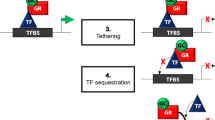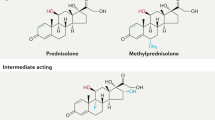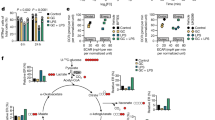Abstract
Glucocorticoids are widely used for the management of inflammatory diseases. Their clinical application stems from our understanding of the inhibitory effect of the corticosteroid hormone cortisol on several components of the immune system. Endogenous and exogenous glucocorticoids mediate their multiple anti-inflammatory effects through many effector molecules. In this Opinion article, we focus on the role of one such effector molecule, annexin A1, and summarize the recent studies that provide insight into its molecular and pharmacological functions in immune responses. In addition, we propose a model in which glucocorticoids regulate the expression and function of annexin A1 in opposing ways in innate and adaptive immune cells to mediate the resolution of inflammation.
This is a preview of subscription content, access via your institution
Access options
Subscribe to this journal
Receive 12 print issues and online access
$209.00 per year
only $17.42 per issue
Buy this article
- Purchase on SpringerLink
- Instant access to full article PDF
Prices may be subject to local taxes which are calculated during checkout




Similar content being viewed by others
References
Serhan, C. N. & Savill, J. Resolution of inflammation: the beginning programs the end. Nature Immunol. 6, 1191–1197 (2005).
Serhan, C. N. et al. Resolution of inflammation: state of the art, definitions and terms. Faseb J. 21, 325–332 (2007).
Gonzalez-Rey, E., Chorny, A. & Delgado, M. Regulation of immune tolerance by anti-inflammatory neuropeptides. Nature Rev. Immunol. 7, 52–63 (2007).
Rhen, T. & Cidlowski, J. A. Antiinflammatory action of glucocorticoids — new mechanisms for old drugs. N. Engl. J. Med. 353, 1711–1723 (2005).
Sapolsky, R. M., Romero, L. M. & Munck, A. U. How do glucocorticoids influence stress responses? Integrating permissive, suppressive, stimulatory, and preparative actions. Endocr. Rev. 21, 55–89 (2000).
Parente, L. & Solito, E. Annexin 1: more than an anti-phospholipase protein. Inflamm. Res. 53, 125–132 (2004).
Gerke, V., Creutz, C. E. & Moss, S. E. Annexins: linking Ca2+ signalling to membrane dynamics. Nature Rev. Mol. Cell Biol. 6, 449–461 (2005).
Morand, E. F. et al. Detection of intracellular lipocortin 1 in human leukocyte subsets. Clin. Immunol. Immunopathol. 76, 195–202 (1995).
Perretti, M. et al. Annexin I is stored within gelatinase granules of human neutrophils and mobilised on the cell surface upon adhesion but not phagocytosis. Cell Biol. Int. 24, 163–174 (2000).
Mulla, A., Leroux, C., Solito, E. & Buckingham, J. C. Correlation between the antiinflammatory protein annexin 1 (lipocortin 1) and serum cortisol in subjects with normal and dysregulated adrenal function. J. Clin. Endocrinol. Metab. 90, 557–562 (2005).
Perretti, M. et al. Mobilizing lipocortin 1 in adherent human leukocytes downregulates their transmigration. Nature Med. 22, 1259–1262 (1996).
Wein, S. et al. Mediation of annexin 1 secretion by a probenecid-sensitive ABC-transporter in rat inflamed mucosa. Biochem. Pharmacol. 67, 1195–1202 (2004).
Solito, E. et al. Post-translational modification plays an essential role in the translocation of annexin A1 from the cytoplasm to the cell surface. Faseb J. 20, 1498–1500 (2006).
Lominadze, G. et al. Proteomic analysis of human neutrophil granules. Mol. Cell. Proteomics 4, 1503–1521 (2005).
Vong, L. et al. Annexin 1 cleavage in activated neutrophils: a pivotal role for proteinase 3. J. Biol. Chem. 282, 29998–30004 (2007).
Rosengarth, A. & Luecke, H. A calcium-driven conformational switch of the N-terminal and core domains of annexin A1. J. Mol. Biol. 326, 1317–1325 (2003).
Perretti, M. & Flower, R. J. Annexin 1 and the biology of the neutrophil. J. Leukoc. Biol. 75, 25–29 (2004).
Lim, L. H. & Pervaiz, S. Annexin 1: the new face of an old molecule. Faseb J. 21, 968–975 (2007).
Lim, L. H., Solito, E., Russo-Marie, F., Flower, R. J. & Perretti, M. Promoting detachment of neutrophils adherent to murine postcapillary venules to control inflammation: effect of lipocortin 1. Proc. Natl Acad. Sci. USA 95, 14535–14539 (1998).
Walther, A., Riehemann, K. & Gerke, V. A novel ligand of the formyl peptide receptor: annexin I regulates neutrophil extravasation by interacting with the FPR. Mol. Cell 5, 831–840 (2000).
Zouki, C., Ouellet, S. & Filep, J. G. The anti-inflammatory peptides, antiflammins, regulate the expression of adhesion molecules on human leukocytes and prevent neutrophil adhesion to endothelial cells. Faseb J. 14, 572–580 (2000).
Hayhoe, R. P. et al. Annexin 1 and its bioactive peptide inhibit neutrophil–endothelium interactions under flow: indication of distinct receptor involvement. Blood 107, 2123–2130 (2006).
Chatterjee, B. E. et al. Annexin 1 deficient neutrophils exhibit enhanced transmigration in vivo and increased responsiveness in vitro. J. Leukoc. Biol. 78, 639–646 (2005).
Mancuso, F., Flower, R. J. & Perretti, M. Leukocyte transmigration, but not rolling or adhesion, is selectively inhibited by dexamethasone in the hamster post-capillary venule. Involvement of endogenous lipocortin 1. J. Immunol. 155, 377–386 (1995).
Frey, O. et al. The role of regulatory T cells in antigen-induced arthritis: aggravation of arthritis after depletion and amelioration after transfer of CD4+CD25+ T cells. Arthritis Res. Ther. 7, R291–R301 (2005).
Yang, Y. H. et al. Modulation of inflammation and response to dexamethasone by annexin-1 in antigen-induced arthritis. Arthritis Rheum. 50, 976–984 (2004).
Ohshima, S. et al. Interleukin 6 plays a key role in the development of antigen-induced arthritis. Proc. Natl Acad. Sci. USA 95, 8222–8226 (1998).
Yang, Y. H. et al. Annexin 1 negatively regulates IL-6 expression via effects on p38 MAPK and MAPK phosphatase-1. J. Immunol. 177, 8148–8153 (2006).
Damazo, A. S. et al. Critical protective role for annexin 1 gene expression in the endotoxemic murine microcirculation. Am. J. Pathol. 166, 1607–1617 (2005).
Perretti, M. et al. Endogenous lipid- and peptide-derived anti-inflammatory pathways generated with glucocorticoid and aspirin treatment activate the lipoxin A4 receptor. Nature Med. 8, 1296–1302 (2002).
Chiang, N. et al. The lipoxin receptor ALX: potent ligand-specific and stereoselective actions in vivo. Pharmacol. Rev. 58, 463–487 (2006).
Babbin, B. A. et al. Annexin I regulates SKCO-15 cell invasion by signaling through formyl peptide receptors. J. Biol. Chem. 281, 19588–19599 (2006).
He, R., Sang, H. & Ye, R. D. Serum amyloid A induces IL-8 secretion through a G protein-coupled receptor, FPRL1/LXA4R. Blood 101, 1572–1581 (2003).
Dahlgren, C. et al. The synthetic chemoattractant Trp-Lys-Tyr-Met-Val-DMet activates neutrophils preferentially through the lipoxin A4 receptor. Blood 95, 1810–1818 (2000).
Solito, E. et al. A novel calcium-dependent pro-apoptotic effect of annexin 1 on human neutrophils. Faseb J. 17, 1544–1546 (2003).
Gao, J.-L., Chen, H., Filie, J. D., Kozak, C. A. & Murphy, P. M. Differential expansion of the N-formylpeptide receptor gene cluster in human and mouse. Genomics 51, 270–276 (1998).
Perretti, M., Getting, S. J., Solito, E., Murphy, P. M. & Gao, J. L. Involvement of the receptor for formylated peptides in the in vivo anti-migratory actions of annexin 1 and its mimetics. Am. J. Pathol. 158, 1969–1973 (2001).
Gavins, F. N., Yona, S., Kamal, A. M., Flower, R. J. & Perretti, M. Leukocyte antiadhesive actions of annexin 1: ALXR- and FPR-related anti-inflammatory mechanisms. Blood 101, 4140–4147 (2003).
Souza, D. G. et al. The required role of endogenously produced lipoxin A4 and annexin-1 for the production of IL-10 and inflammatory hyporesponsiveness in mice. J. Immunol. 179, 8533–8543 (2007).
Ferlazzo, V. et al. Anti-inflammatory effects of annexin-1: stimulation of IL-10 release and inhibition of nitric oxide synthesis. Int. Immunopharmacol. 3, 1363–1369 (2003).
Clark, A. R. Anti-inflammatory functions of glucocorticoid-induced genes. Mol. Cell. Endocrinol. 275, 79–97 (2007).
Goulding, N. J. et al. Anti-inflammatory lipocortin 1 production by peripheral blood leucocytes in response to hydrocortisone. Lancet 335, 1416–1418 (1990).
Solito, E., de Coupade, C., Parente, L., Flower, R. J. & Russo-Marie, F. IL-6 stimulates annexin 1 expression and translocation and suggests a new biological role as class II acute phase protein. Cytokine 10, 514–521 (1998).
Hannon, R. et al. Aberrant inflammation and resistance to glucocorticoids in annexin 1−/− mouse. Faseb J. 17, 253–255 (2003).
Damazo, A. S., Yona, S., Flower, R. J., Perretti, M. & Oliani, S. M. Spatial and temporal profiles for anti-inflammatory gene expression in leukocytes during a resolving model of peritonitis. J. Immunol. 176, 4410–4418 (2006).
Sawmynaden, P. & Perretti, M. Glucocorticoid upregulation of the annexin-A1 receptor in leukocytes. Biochem. Biophys. Res. Commun. 349, 1351–1355 (2006).
Ehrchen, J. et al. Glucocorticoids induce differentiation of a specifically activated, anti-inflammatory subtype of human monocytes. Blood 109, 1265–1274 (2007).
Hashimoto, A., Murakami, Y., Kitasato, H., Hayashi, I. & Endo, H. Glucocorticoids co-interact with lipoxin A4 via lipoxin A4 receptor (ALX) up-regulation. Biomed. Pharmacother. 61, 81–85 (2007).
Croxtall, J. D., van Hal, P. T., Choudhury, Q., Gilroy, D. W. & Flower, R. J. Different glucocorticoids vary in their genomic and non-genomic mechanism of action in A549 cells. Br. J. Pharmacol. 135, 511–519 (2002).
Franchimont, D. Overview of the actions of glucocorticoids on the immune response: a good model to characterize new pathways of immunosuppression for new treatment strategies. Ann. NY Acad. Sci. 1024, 124–137 (2004).
Van Laethem, F. et al. Glucocorticoids attenuate T cell receptor signaling. J. Exp. Med. 193, 803–814 (2001).
Van Laethem, F., Baus, E., Andris, F., Urbain, J. & Leo, O. A novel aspect of the anti-inflammatory actions of glucocorticoids: inhibition of proximal steps of signaling cascades in lymphocytes. Cell. Mol. Life Sci. 58, 1599–1606 (2001).
Adcock, I. M. Glucocorticoid-regulated transcription factors. Pulm. Pharmacol. Ther. 14, 211–219 (2001).
Ramirez, F., Fowell, D. J., Puklavec, M., Simmonds, S. & Mason, D. Glucocorticoids promote a TH2 cytokine response by CD4+ T cells in vitro. J. Immunol. 156, 2406–2412 (1996).
Ramirez, F. Glucocorticoids induce a Th2 response in vitro. Dev. Immunol. 6, 233–243 (1998).
Elenkov, I. J. Glucocorticoids and the Th1/Th2 balance. Ann. NY Acad. Sci. 1024, 138–146 (2004).
Richards, D. F., Fernandez, M., Caulfield, J. & Hawrylowicz, C. M. Glucocorticoids drive human CD8+ T cell differentiation towards a phenotype with high IL-10 and reduced IL-4, IL-5 and IL-13 production. Eur. J. Immunol. 30, 2344–2354 (2000).
D'Acquisto, F. et al. Annexin-1 modulates T-cell activation and differentiation. Blood 109, 1095–1102 (2007).
D'Acquisto, F. et al. Impaired T cell activation and increased Th2 lineage commitment in annexin-1-deficient T cells. Eur. J. Immunol. 37, 3131–3142 (2007).
Ebisuya, M., Kondoh, K. & Nishida, E. The duration, magnitude and compartmentalization of ERK MAP kinase activity: mechanisms for providing signaling specificity. J. Cell Sci. 118, 2997–3002 (2005).
Boyton, R. J. & Altmann, D. M. Is selection for TCR affinity a factor in cytokine polarization? Trends Immunol. 23, 526–529 (2002).
Marti, F., Lapinski, P. E. & King, P. D. The emerging role of the T cell-specific adaptor (TSAd) protein as an autoimmune disease-regulator in mouse and man. Immunol. Lett. 97, 165–170 (2005).
Tagoe, C. E. et al. Annexin-1 mediates TNF-α-stimulated matrix metalloproteinase secretion from rheumatoid arthritis synovial fibroblasts. J. Immunol. 181, 2813–2820 (2008).
D'Acquisto, F. et al. Glucocorticoid treatment inhibits annexin-1 expression in rheumatoid arthritis CD4+ T cells. Rheumatology (Oxford) 47, 636–639 (2008).
Caramori, G. et al. Expression of GATA family of transcription factors in T-cells, monocytes and bronchial biopsies. Eur. Respir. J. 18, 466–473 (2001).
Zhou, M. & Ouyang, W. The function role of GATA-3 in Th1 and Th2 differentiation. Immunol. Res. 28, 25–37 (2003).
Jee, Y. K. et al. Repression of interleukin-5 transcription by the glucocorticoid receptor targets GATA3 signaling and involves histone deacetylase recruitment. J. Biol. Chem. 280, 23243–23250 (2005).
Barrionuevo, P. et al. A novel function for galectin-1 at the crossroad of innate and adaptive immunity: galectin-1 regulates monocyte/macrophage physiology through a nonapoptotic ERK-dependent pathway. J. Immunol. 178, 436–445 (2007).
Anderson, A. C. et al. Promotion of tissue inflammation by the immune receptor Tim-3 expressed on innate immune cells. Science 318, 1141–1143 (2007).
Ito, K. et al. Histone deacetylase 2-mediated deacetylation of the glucocorticoid receptor enables NF-κB suppression. J. Exp. Med. 203, 7–13 (2006).
Song, I. H. & Buttgereit, F. Non-genomic glucocorticoid effects to provide the basis for new drug developments. Mol. Cell. Endocrinol. 246, 142–146 (2006).
Lowenberg, M. et al. Glucocorticoids cause rapid dissociation of a T-cell-receptor-associated protein complex containing LCK and FYN. EMBO Rep. 7, 1023–1029 (2006).
Moraes, L. A. et al. Ligand-specific glucocorticoid receptor activation in human platelets. Blood 106, 4167–4175 (2005).
Badolato, R. et al. Serum amyloid A induces calcium mobilization and chemotaxis of human monocytes by activating a pertussis toxin-sensitive signaling pathway. J. Immunol. 155, 4004–4010 (1995).
Le, Y. et al. Amyloid β42 activates a G-protein-coupled chemoattractant receptor, FPR-like-1. J. Neurosci. 21, RC123 (2001).
Fu, H. et al. Ligand recognition and activation of formyl peptide receptors in neutrophils. J. Leukoc. Biol. 79, 247–256 (2006).
Le, Y. et al. Identification of functional domains in the formyl peptide receptor-like 1 for agonist-induced cell chemotaxis. Febs J. 272, 769–778 (2005).
Rodrigues-Lisoni, F. C. et al. In vitro and in vivo studies on CCR10 regulation by annexin A1. FEBS Lett. 580, 1431–1438 (2006).
Lange, C., Starrett, D., Goetsch, J., Gerke, V. & Rescher, U. Transcriptional profiling of human monocytes reveals complex changes in the expression pattern of inflammation-related genes in response to the annexin A1-derived peptide Ac1–25. J. Leukoc. Biol. 82, 1592–1604 (2007).
Burli, R. W. et al. Potent hFPRL1 (ALXR) agonists as potential anti-inflammatory agents. Bioorg. Med. Chem. Lett. 16, 3713–3718 (2006).
Gilmour, J. S. et al. Local amplification of glucocorticoids by 11 β-hydroxysteroid dehydrogenase type 1 promotes macrophage phagocytosis of apoptotic leukocytes. J. Immunol. 176, 7605–7611 (2006).
Liu, Y. et al. Glucocorticoids promote nonphlogistic phagocytosis of apoptotic leukocytes. J. Immunol. 162, 3639–3646 (1999).
Scannell, M. et al. Annexin-1 and peptide derivatives are released by apoptotic cells and stimulate phagocytosis of apoptotic neutrophils by macrophages. J. Immunol. 178, 4595–4605 (2007).
Maderna, P., Yona, S., Perretti, M. & Godson, C. Modulation of phagocytosis of apoptotic neutrophils by supernatant from dexamethasone-treated macrophages and annexin-derived peptide Ac2–26. J. Immunol. 174, 3727–3733 (2005).
Acknowledgements
Work in our laboratory is funded by the Arthritis Research Campaign UK, the Wellcome Trust, the British Heart Foundation and the Medical Research Council UK. We apologize to the many colleagues whose work could not be cited here owing to space limitations.
Author information
Authors and Affiliations
Corresponding author
Ethics declarations
Competing interests
M.P. declares licensing of a patent on ANXA1-derived anti-inflammatory peptides to Unigene Corp (Fairfield, New Jersey).
Related links
Rights and permissions
About this article
Cite this article
Perretti, M., D'Acquisto, F. Annexin A1 and glucocorticoids as effectors of the resolution of inflammation. Nat Rev Immunol 9, 62–70 (2009). https://doi.org/10.1038/nri2470
Issue Date:
DOI: https://doi.org/10.1038/nri2470
This article is cited by
-
The interplay between obesity, immunosenescence, and insulin resistance
Immunity & Ageing (2024)
-
Intercellular communication atlas reveals Oprm1 as a neuroprotective factor for retinal ganglion cells
Nature Communications (2024)
-
Annexin A1 is a polarity cue that directs mitotic spindle orientation during mammalian epithelial morphogenesis
Nature Communications (2023)
-
Molecular analysis of Annexin expression in cancer
BMC Cancer (2022)
-
Annexin A1 promotes the progression of bladder cancer via regulating EGFR signaling pathway
Cancer Cell International (2022)



